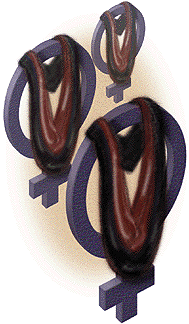
 The University of Chicago Magazine April 1996
The University of Chicago Magazine April 1996


Mother Hood
I didn't
intend for it
to be a once-
in-a-lifetime
keepsake
Our old Victorian home in Hyde Park has three floors and a full basement, seven bedrooms, five bathrooms, and about a dozen closets, jammed with books, records, and the accumulated litter of three generations. Last Mother's Day, I found myself busily hunting for the two University of Chicago hoods I had stored for safekeeping somewhere in the house. One hood had been presented in 1919 to my father, Raleigh W. Stone; the other was given to my mother, Ursula B. Stone, a decade later, when she became the first woman in the nation to earn a Ph.D. from a school of business.
As our daughter, Elizabeth, was about to receive her Ph.D. in history from Chicago, I had decided to give her one of the hoods. I didn't intend for the hood to be a once-in-a-lifetime keepsake because, like both grandparents, Elizabeth had a teaching job where she would wear it. But I did see the garment as a gentle reminder that her academic achievements were not unique in our family or our community.
Growing up in Hyde Park, the women I knew were mostly married with children--but they were also administrators, authors, doctors, editors, professors, and politicians who made friendly but formidable role models. Their community activities and professional careers had been determined as much by an ongoing tradition of women's higher education and public responsibility as by economic need.
My mother and many of her closest friends came from small, Midwestern towns-towns where their own mothers, aunts, and grandmothers had marched for the vote, built libraries, started visiting-nurse services, and run church programs and schools. Like my mother, most of these women were Chicago-educated-not a surprising fact since, from its beginnings, the U of C had recruited the young women interested in, to use my dad's favorite phrase, "amounting to something."
In this sense, my daughter was simply part of an ongoing tradition. What could be more natural-when her baby-sitters were her grandmother's students and one of our seven bedrooms was my study, where I wrote the books whose dust jackets I pin upon the wall like trophies? Like me and my mother before me, Elizabeth had been raised in a community where women did not fit the cookie-cutter stereotypes of "wife" and "mother."
Of these women, my earliest and most important mentors were my mother and her lifelong friend, Rachel Marshall Goetz, PhB'25, MBA'27, who met as graduate students. Neither Mom, tall and blond, nor Rae, short and brunette, specialized in being "glamour girls" of leisure. Instead, I recall mornings when Mom-in suit and hat, her gloved hand clutching a briefcase-strode briskly out the door and
around the corner to meet Rae and catch the I.C. to the Loop just as I left to walk to the Lab Schools with Dad, on his way to the University. I knew Mom and Rae ran a research firm called Batchelder and Marshall (their maiden names) because I scribbled on their stationery and took tea to their typist, Miss Gleason, who worked in Mom's upstairs office.
As I grew up, both women remained active on many fronts, volunteer and paid: Mom teaching, and Rae, writing and editing. Both put me to work, as well, grading exams and doing freelance editing. But regarding Hyde Park and the University, my most enduring memory of my mother's professional life is the night of March 27, 1952. Home from college on spring break, I went with my family to a crowded meeting at Mandel Hall, called by community leaders concerned about an increase in crime in the area so drastic that it seemed to threaten the very survival of the neighborhood. Many wondered if the University might be better off abandoning Hyde Park altogether, and fleeing to the suburbs. Instead, the ad hoc committee proposed setting up a Committee of Five to recommend positive community action. When the chair read out the nominees' names, four were prominent Chicago men, including the University's president. The fifth was my mother.
This Committee of Five set up the South East Chicago Commission, charged with devising a strategy to stem urban decay while integrating the neighborhood. If they had failed, it's uncertain that we would have been able to remain in this old Victorian house, where I wrote my books and where we raised our daughter.
Small wonder that while I looked forward to seeing Elizabeth receive her Ph.D.- knowing that both her grandparents would have been very pleased-I didn't feel as if some great revolution was transpiring in human affairs. Instead, when I found the drawer in the closet where I had stashed both hoods in a plastic bag, and discovered that Dad's hood was much less worn than Mom's, I was perfectly comfortable giving that hood to Elizabeth. Growing up in Hyde Park, she doesn't have to prove anything. Just use it.
Alzina Stone Dale, AM'57, is the author of a number of books-her latest, Mystery Reader's Walking Guide: Chicago, follows the paths of mystery writers and their sleuths.